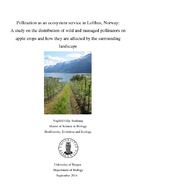| dc.description.abstract | Pollination is an important ecosystem service that benefits human welfare by increasing the quantity and quality of fruit and seed set of many crops. The decline in bee abundance and diversity in recent years may result in a decrease in pollination services, which could have a major impact on world food supplies. In Norway, there is a lack of studies on pollination in a farming context. Here I present a field study on the pollination service in apple orchards in Lofthus, Western Norway. I studied the distribution of managed and wild bees, factors that affect their presence, and how this affects the apple yield. The field methods used were transect walks at the farms, observations at branches, pan traps and transect in various habitat types. Transect walks at farms and observations at branches and pan traps were used for statitstical analyses, while transect walks in various habitat types were combined and used to create a species distribution model (SDM). There was a high abundance of honeybees in the apple orchards; among the wild pollinators bumblebees were more common. Honeybees were more abundant in sunny weather, while bumblebees were not as strongly affected by weather. Bumblebee abundance increased towards higher elevations on the farms in the transect walk data, while SDM showed increasing elevations (up to 240 meter) to have a positive effect on predicted presence of both honeybee and bumblebees. Distance to forest did not affect the bumblebees, but SDM showed that all of the pollinators preferred the upper, less disturbed parts of the farm areas which were closer to natural habitats. I also showed that pollinator diversity had a positive impact on the fruit set and yield. These results indicate that both honeybee and bumblebee abundance have a positive impact on the fruit set and yield of apples in Lofthus. They also indicate that to enhance the wild pollinator abundance, undisturbed, flower rich habitat is important. | en_US |
